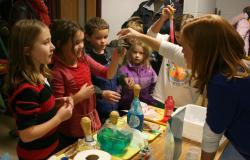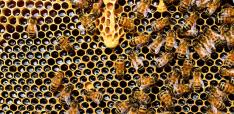Teach Girls Science and they'll Reach for the Stars. I Should Know

Grier Wilt outlines what is needed to assure girls can pursue careers in STEM.
At the turn of the decade, 20% of all jobs in the US required high-level knowledge in science, technology, engineering or maths. What’s more, empowering young children - and especially girls - with skills and experiences in these fields can have a positive and lasting impact on a child’s life. I am one such example.
Growing up in rural central Pennsylvania had its advantages and disadvantages. One major advantage were the clear skies, free from light pollution, that allowed me to imagine myself exploring among the stars. It is what planted within me the desire to become an astronaut.
However, I had limited exposure to the sciences that would allow me to reach those stars. With a lack of economic wealth, a struggling education system and a dearth of science, technology, engineering and maths (STEM) career pathways, my hometown presented challenges in the way of my goals. Fortunately, my parents actively pursued free educational programmes that changed my life for the better.
The additional exposure to the sciences opened up my world and ultimately allowed me to attend university, pursue a STEM degree and have a dream career at NASA.
Saturday Science, a free community science-based education programme, had a major impact on my life. Geared towards students between the ages of five to 14, these programmes offer students the opportunity to explore STEM subjects one Saturday morning each month at Susquehanna University. Through the steadfastness and dedication of its creator, Dr. Jack Holt, a professor of biology at the university, the programme is now in its 30th year.
By the age of nine, I was solving classical mechanics equations, extracting DNA from vegetables, dissecting animals, and discussing Einstein’s theory of general relativity. While I may not have fully comprehended all of the concepts at such a young age, it did not matter: I was being exposed to science in a way that made it exciting and accessible to me.
Through my years attending Saturday Science, I gained the confidence to explore more on my own. I can recall my first experience with coding. I used a simple text editor called Notepad - just a white screen with black text - to experiment, and it was my entryway into a world of creativity and invention. I created websites from scratch; they contained sound files, animations of a spaceship flying around on the screen, and my science experiments and thoughts.
It was my way to connect with the world from the living room of my home in a tiny, rural town. It was a creative outlet of expression, and a challenge I embraced. I would write lines of code, expecting a certain outcome, and fail. I would re-evaluate my code or try a new technique until I achieved the result I wanted. Coding was a skill that I could build upon, learn from, and gain confidence in; something that is indispensable for developing young girls.
Later in university, when I was introduced to those same subjects again, it was not intimidating. I recalled with fondness my practical experience with those topics and I knew I could confidently solve the problems before me. Despite being one of the only women in the room, which felt isolating at times, I did not question my validity or ability to be in that room. I had already proven to myself that I possessed the competence to learn new subject matter and the confidence to solve problems.
Pursuing a science or engineering career comes naturally when students are equipped with STEM skills at a young age. Hands-on, interactive education in STEM is the sporting equivalent of giving a girl a basketball and teaching her to dribble and shoot. Teaching skills is far more powerful than teaching the theory of the sport. Once she knows how to dribble and shoot, she can practice on her own, try different techniques or stretch her boundaries. Providing girls with STEM skills such as coding enables them to practice on their own and gain confidence with continued improvement. Exploring and then harnessing a concept is incredibly rewarding psychologically.
While I did not become a world-class computer programmer as a result of my early STEM education, I did gain the necessary confidence to expand my skills and pursue a career as an engineer. This eventually helped me to achieve my lifelong dream of reaching the stars through my work at NASA. This is why I feel so passionately about encouraging young girls to explore STEM, especially considering that society does not necessarily socialize them to do so.
In fact, female students’ achievement in mathematics and science is on par with their male counterparts and their participation rates in these courses are similar to their male peers, with one serious exception: computer science and engineering. This statistic needs to change.
My work at NASA demonstrates why. I work as an extravehicular activities task flight controller and instructor, designing spacewalk missions to install or repair hardware aboard the International Space Station. I then work with a team of teams from around the world to support astronauts as they perform those spacewalks. I would have never thought that coding as a little girl would lay the foundation for the skills required in my current role. While the astronauts do not execute code, they do work through procedures that I designed and scripted in order to accomplish their mission. It was the exposure I gained as a young girl in science and engineering that gave me the technical foundation and confidence to be part of this multicultural worldwide team working together to push the bounds of human exploration.
Exposing young girls to analytical problem-solving and hands-on experimentation through programmes like Saturday Science gives them the foundation and confidence to enable them to succeed in STEM fields; it is one of the best ways to create gender equity in this area.
Through the investment of consistent skills-focused programmes such as these, we can better enable future generations to not feel intimidated by challenges or strong opinions, but rather see them as a problem to solve, to have their voices heard, and to unleash their potential in order to make an incredible impact upon the world.
Grier Wilt, Spacewalk Instructor and Flight Controller, NASA Johnson Space Center.
This first appeared on the World Economic Forum's Agenda blog.
Image credit: woodleywonderworks via Flickr (CC BY 2.0)


